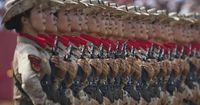On the morning of September 3, 2025, the heart of Beijing pulsed with the sound of martial music and the thunder of military hardware, as China marked the 80th anniversary of Japan’s surrender and the end of World War II with a grand military parade in front of Tiananmen Gate. The event, attended by Chinese President Xi Jinping, Russian President Vladimir Putin, and North Korean leader Kim Jong Un, was a powerful reminder of the war’s enduring legacy and China’s evolving role on the world stage, according to The Associated Press.
The anniversary, known internationally as VJ Day (Victory over Japan Day), commemorates the moment on August 15, 1945, when Japan announced its surrender to the Allied forces, bringing the global conflict to a close. For China, the day is more than a historical milestone; it is a symbol of national resilience, unity, and the sacrifices made in the War of Resistance Against Japanese Aggression and the World Anti-Fascist War.
China’s capital was transformed into a tableau of remembrance and military might. According to AP, the spectacle featured thousands of military personnel marching in disciplined formations, a formidable display of armored vehicles, and cutting-edge technology including the GJ-11 stealth unmanned combat aerial vehicle and the AJX002 underwater drone. The DF-5C liquid-fueled intercontinental strategic nuclear missiles rolled past the crowds, while helicopters and jets soared overhead in tight formation. The Chinese flag was raised with solemn ceremony, underscoring the event’s patriotic fervor.
President Xi Jinping, standing at the helm, inspected the troops before the parade commenced. His image, projected onto a giant screen, watched over the proceedings, a modern echo of China’s wartime leadership. After the parade, Xi attended a formal reception, where the nation’s leaders and honored guests reflected on the meaning of the day.
But the commemoration extended far beyond the parade ground. Across China, churches and Christian communities marked the anniversary with a different kind of solemnity. On August 13, 2025, the China Christian Council and the Three-Self Patriotic Movement (CCC&TSPM) issued a call for nationwide "Peace Prayers" from August 15 to 17, urging believers to honor history, remember the sacrifices of those who came before, and pray for world peace, national prosperity, and humanity’s well-being. Their statement described Christ as the "Prince of Peace," and encouraged the faithful to actively contribute to a harmonious future.
Local congregations responded with a rich tapestry of commemorative activities. In Beijing, Kuanjie Church hosted calligraphy events that wove together artistic expression and historical memory. In Guangzhou, churches organized film screenings of "Dead to Rights," a powerful depiction of the Nanjing Massacre. The Taizhou Jiaojiang Church choir paid a visit to a Red Heritage exhibition, while Shanghai’s Holy Trinity Church offered a lecture recounting the stories of Christians during the war years.
These events were not mere rituals—they were acts of remembrance rooted in a long tradition of Christian engagement during some of China’s darkest hours. As detailed by the China Christian Council, the role of Chinese Christians during the Anti-Japanese War was both patriotic and humanitarian. In July 1937, as conflict erupted, the National General Assembly of the Chinese Christian Church in Qingdao publicly condemned Japan’s invasion and called on churches to provide battlefield services and relief. Shanghai’s Christian Association and the Shanghai Christian Union rallied believers to support national defense, and similar appeals echoed from Guangzhou to the wartime capital of Chongqing.
Patriotic movements took many forms. The "Every Penny Relief Campaign"—a grassroots fundraising effort—collected over 219,000 yuan by 1938, channeling aid to 38 regions across the country. Christian-run refugee shelters in Shanghai alone served about 150,000 people, while a central food distribution center reached another 300,000. Relief committees, temporary reception centers, and educational programs sprang up in cities from Beijing and Wuhan to Hong Kong and Leshan, providing food, clothing, medical care, and hope to displaced civilians. Christian youth and women’s organizations played a vital role in supporting students forced from their homes by the war.
Music and culture also became tools of resistance. Liu Liangmo, a Christian leader and musician, founded the People’s Song Association in 1935, popularizing patriotic songs such as "The March of the Volunteers." After the Lugou Bridge Incident, Liu led the YMCA Military Service Department, traveling to the front lines to inspire soldiers and civilians alike. Even after being exiled to the United States in 1940, he continued to teach Chinese patriotic songs abroad. By 1949, "The March of the Volunteers" had become China’s national anthem, a testament to the enduring power of music in shaping national identity.
Chinese Christians also leveraged international networks to draw support and attention to their plight. In August 1937, twenty leading Christians in Shanghai sent an open letter to churches worldwide, denouncing Japanese aggression and appealing for solidarity. Leaders from the nationwide Christian Association, the YMCA, and the YWCA petitioned the International Alliance to sanction Japan. Western churches, including the American International Mission Council, the Episcopal Church, the Presbyterian Church, and the Church of England, responded with statements of support and tangible aid. During the Nanjing Massacre in December 1937, foreign missionaries helped establish the Nanjing Safety Zone, which sheltered approximately 250,000 civilians from violence and chaos.
The 80th anniversary commemorations, therefore, were not just about military triumph or political symbolism. They were about remembering a broad tapestry of sacrifice and solidarity—soldiers on the battlefield, civilians in shelters, artists and musicians raising spirits, and communities of faith offering comfort and aid. The past, as these events made clear, is not a distant country. It is alive in the prayers of congregations, the lessons of history, and the determination to build a more peaceful future.
As the sun set on Beijing’s parade and the echoes of prayers faded across China, the message was unmistakable: honoring the past is inseparable from shaping the future. Whether through the disciplined ranks on Tiananmen Square or the quiet reflection in church pews, China’s commemoration of VJ Day in 2025 was a call for remembrance, unity, and peace—values as urgent today as they were eighty years ago.




